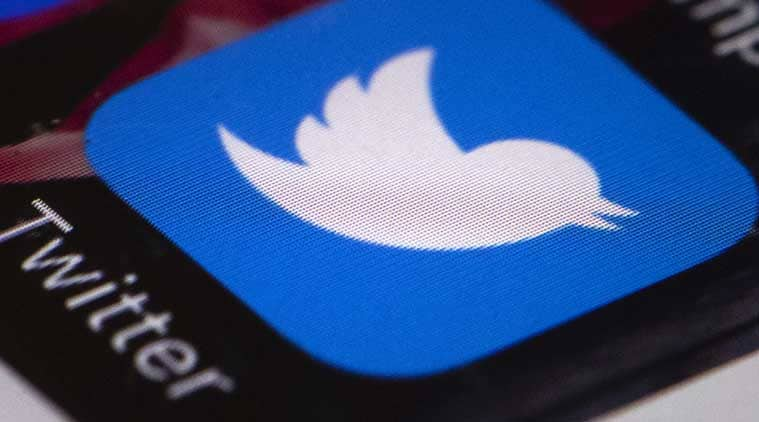
Automated Twitter ‘bots’ were boosting hashtags and trying to manipulate traffic on Twitter in February 2019 ahead of the Lok Sabha 2019 elections, according to a study done by the Digital Forensic Research Lab (DFRLab), part of US-based think tank The Atlantic Council.
DFRLab analysed two hashtags in particular #TNwelcomesModi and #GoBackModi and found in its analysis that the traffic on both of these was heavily manipulated.
“So both hashtags, #TNWelcomesModi and #GoBackModi trended three times this year — January 25 – 29 , February 9 – 12 and March 4 – 7. All three times, they were heavily manipulated by bots, but between February 9 -12 the bot manipulation was off the charts. All three campaigns, like most Twitter campaigns, were short-lived, meaning that after the first couple of days, the campaigns stopped,” explained Donara Barojan, Assistant Director at DFRLab in an email response to the indianexpress.com.
DFRLab has in particular analysed the traffic on February 9-10 noting that the bot accounts were “deployed on a massive scale,” for these two dates. However, it did not link the bots or the accounts behind this traffic to any political party.
“We cannot attribute the bots to the two political parties. We have no evidence to link the political parties to the botnets. All we can say is that the political parties benefited from the bots,” wrote Barojan.
According to the report, both the pro-Modi and anti-Modi traffic and hashtags were heavily manipulated. In fact, compared to other globally manipulated trends that DFRLab has observed on Twitter in the past, these hashtags from India were well ahead of the rest.
The study also shows these accounts were domestic in origin. “The accounts that we analysed appeared to have been created for the sole purpose of amplifying political campaigns in India. Because we rely on Open Source information only, we cannot be 100 per cent sure they were run out of India, but there are no indicators suggesting they were run from abroad,” said Barojan.
It also appears that “the pro-Modi traffic was far more heavily manipulated than the anti-Modi traffic,” according to DFRLab. But the agency also notes that while the scale of the traffic was vast, the impact was low, since the accounts used for the campaign had relatively low number of followers of the accounts.
DFRLab relied on a formula known as Coefficient of Traffic Manipulation or CTM to analyse the traffic on these hashtags. This CTM was first published by the Oxford Internet Institute Computational Propaganda project and takes three numerical values from a given Twitter flow: the percentage of traffic that is made up of simple retweets; the percentage of traffic generated by the 50 most active accounts; and the average number of posts per user in the flow.
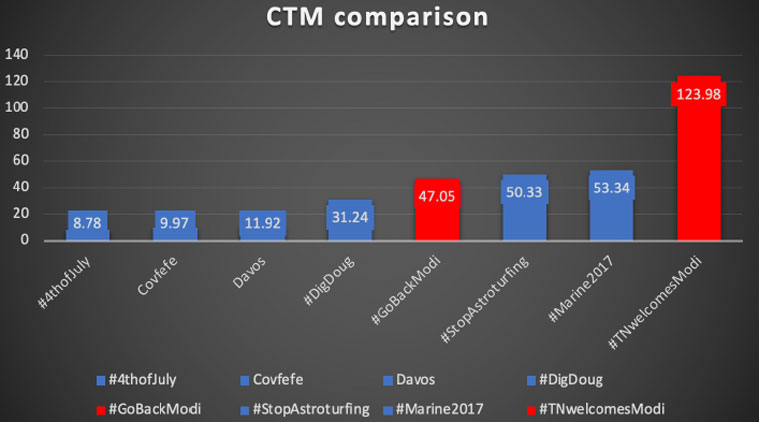
In earlier studies, organic and non-manipulated traffic around a trend on Twitter typically scored a CTM of 12 or lower. Heavily manipulated traffic that was boosted by bots and coordinated human users scored up to 60. The #TNwelcomesModi had a CTM of 123.98, while #GoBackModi had a CTM of 47.05, thus showing just how heavily manipulated the pro-Modi trend was in comparison.
In contrast, organic trends like #4thofJuly, “Davos” during the World Economic Forum and the initial traffic on the word “covfefe,” all had a CTM score of less than 12, indicating these three were not manipulated, explain DFRLab’s blog post.
“The reason we used CTM was that it‘s designed to be able to compare different traffic flows, using the same indicators. That means you can compare two flows happening at the same time, but you can also compare them with earlier traffic flows which have already been studied. It‘s not about getting a binary result, manipulated / not manipulated: it‘s about identifying how serious the attempt was, and giving a first indication of what tools were used,” explained Ben Nimmo, Senior Fellow for Information Defense at DFRLab on the method used to analyse this traffic.
According to DFRLab, this system is “designed to situate a given traffic flow on the spectrum between organic and heavily manipulated content” and this works irrespective of whether the manipulation is being done by bots or automated accounts or actual human accounts or even a combination of the two.”
The hashtag #TNwelcomesModi, which trended in India on February 9–10 and was mentioned over 777,000 times in two days. The first 49,727 tweets in #TNwelcomesModi scored a CTM of 123.98, the highest the DFRLab has ever recorded, indicating that it was very heavily manipulated by a very small group.
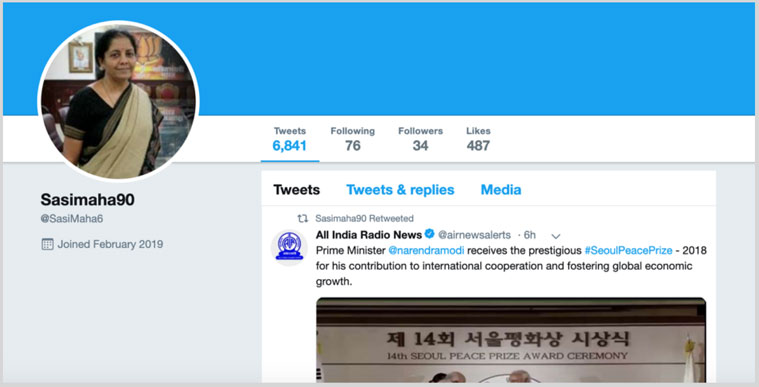
DFRLab also analysed some accounts behind these hashtags, most of which were bots and have been suspended. The most frequently posting account was @SasiMaha6, which posted #TNwelcomesModi tweets 1,803 times during the scan, or roughly one tweet every 15 seconds.
The account was created on February 4, 2019; the page was archived on February 22, 2019, by which time it had posted 6,841 times, for an average of 380 posts per day. Another high-volume account was @priyamanaval6, which posted the hashtag 1,677 times, or roughly one tweet every 17 seconds for over seven hours. This account, too, was created on February 4, 2019.
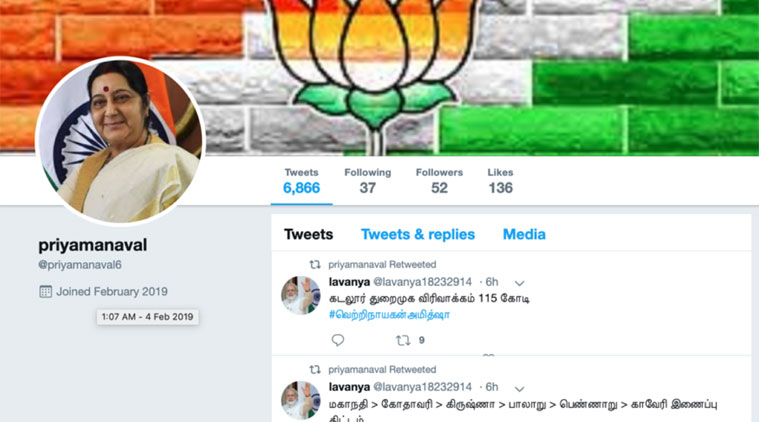
“These sustained rates are far too high for human posting. The top three accounts alone posted #TNwelcomesModi 4,914 times, or roughly 10 percent of all traffic in the scan,” showed the study.
Almost two-thirds of the posts that initiated #TNwelcomesModi and pushed it to trend came from just 50 accounts.
The #GoBackModi trend had 49,538 tweets in just over three hours in the early morning of February 10. It peaked at a lower rate, however, generating 447,000 posts on February 9–10. This had a CTM score of 46.81, far above the usual range for organic traffic, though in comparison to the pro-Modi effort, it was much lower. However, some of the accounts pushing this hashtag have still not been suspended.
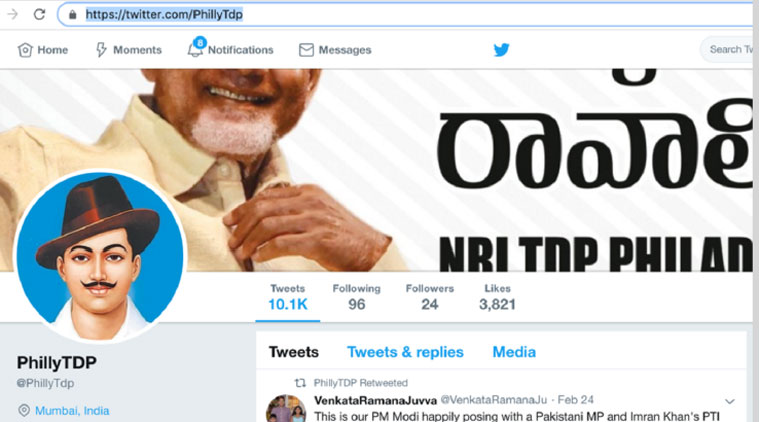
The most active was account behind this was @PhillyTdp, which posted on #GoBackModi 2,179 times or nearly one tweet every 5.3 seconds for over three hours. Also 98 per cent of all the tweets from this particular account since February 9 were retweets.

The second most active account was @nritdpusa which posted 1,899 times in three hours, or roughly one tweet every 10 seconds.
According to DFRLab, these individual bots were even more prolific than their pro-BJP rivals, but the overall scan of this hashtag revealed a larger number of lower-activity accounts. Overall, the nearly 50,000 tweets in the #TNwelcomesModi scan were posted by just 891 accounts, while the nearly 50,000 tweets in the #GoBackModi scan were posted by 7,394 Accounts.
DFRLab said it monitors Twitter traffic in India weekly. Barojan added that they have noticed that there are many political campaigns amplified by bots, “but the two we analysed in the article were amplified by bots significantly more than anything else we’ve seen before.”
On looking for bots, Nimmo explained that there are three A’s to rely on, “activity, anonymity, and amplification.”
“If an account is posting hundreds of times in a single day, almost exclusively posts retweets, and doesn’t give any verifiable personal information, it‘s likely to be a bot,” he wrote.